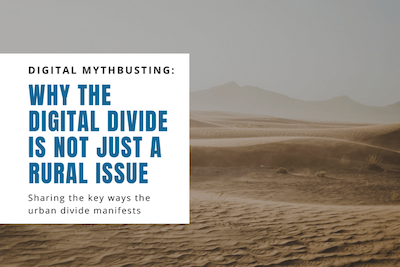Myth: The digital divide only impacts rural communities
In the realm of digital equity, there is a common misconception that the digital divide is predominantly a problem faced by rural communities that lack adequate broadband infrastructure and strong internet signals.
However, contrary to popular belief, urban areas also experience significant disparities in digital access and skills. While cities often have better infrastructure and higher internet penetration rates, it is crucial to recognize that not all urban communities enjoy equal access to technology. In particular, low-income urban communities still face major challenges in accessing technology. In this post, we will look at the urban-rural digital divide.
The urban digital divide manifests in several key ways
-
Access to Affordable Internet
Low-income urban communities often face cost barriers in accessing internet services. Limited competition among internet service providers in certain areas can drive up pricing, making it challenging for individuals to afford monthly internet plans.
-
Availability of Affordable Devices
The cost of devices can also be a significant barrier to digital inclusion in urban areas. Many individuals in low-income communities struggle to afford computers, laptops, and tablets.
-
Digital Skills and Literacy
The digital divide is not solely about access to technology but also encompasses digital skills and literacy. Low-income urban communities often face challenges in acquiring the necessary digital skills to fully participate in the digital age. Without adequate training and support, individuals may lack the confidence and knowledge to navigate digital platforms, conduct online research, or use digital tools effectively.
-
Technological Infrastructure
While urban areas generally have better tchnological infrastructure, disparities still exist within cities. Underserved neighborhoods and communities may have outdated or inadequate infrastructure, resulting in slower internet speeds and unreliable connectivity. This is largely due to digital redlining, as internet service providers often intentionally underinvest in low-income, minority communities, assuming that they will earn larger profits in wealthier, whiter neighborhoods.
In general, socioeconomic factors play a crucial role in perpetuating the urban rural digital divide, irrespective of the setting. In both rural and urban areas, income inequality affects individuals’ ability to afford reliable internet services and necessary devices. Low-income urban communities are often situated in underserved neighborhoods and are hit hard by this disparity, which only exacerbates already-existing social and economic inequalities.
Overall, the notion that the digital divide is solely a rural issue is an oversimplification that masks the complex realities of digital inequities. By debunking this myth, we emphasize the need for comprehensive efforts to bridge the divide in both rural and urban areas. It is only through recognizing the multifaceted nature of the digital divide that we can work towards achieving true digital equity and creating a more inclusive society for all.
This is the third in a series of blog posts about digital myths. See parts one and two.


Comments are closed.